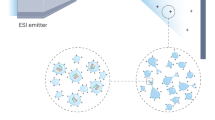Abstract
An oligonucleotide tends to release hydrogen atoms from a phosphoric acid group and to form negative ions that can be detected by mass spectrometry. Usually, with a solution-spray based ionization technique, the negative ions are present in different charge states. Ion formation for the nucleotide is quite complicated and is easily influenced by matrix and other constituents in a sample solution, as well as by the operating parameters for a mass spectrometer. In this work, we studied oligonucleotide ion formation by using an ion trap mass spectrometer combined with a sonic spray ionization (SSI) source. An oligonucleotide with 20 bases was measured. Effects from contaminants and parameters affecting the ion production, such as a high voltage applied to the ionization source and sample solution-flow rate, were investigated. Our results showed that an ion with about one charge for every three bases was most abundant. However, the signal intensity and the mass spectrum pattern were sensitive to the matrix and operating parameters. One of the reasons for such sensitivity is that there are various ion states for an oligonucleotide. Any change in the matrix or an operating parameter may shift the balances between the ion states. Adding Tris, or (hydroxymethyl)aminomethane, enhanced the signal intensity of the oligonucleotide and promoted formation of the oligonucleotide ion with higher charges, while adding acetic acid favored the ions with lower charges, compared with that obtained in the medium without adding Tris and acetic acid. The effects on charged droplets and chemical enhancement were investigated. The mechanism for oligonucleotide ion formation is discussed.
Similar content being viewed by others
References
E. S. Lander, Science, 1996, 274, 536.
H. Köter, K. Tang, D. Fu, A. Braun, D. Boom, C. L. Smith, R. C. Cotter, and R. C. Cantor, Nature Biotechnology, 1996, 14, 1123.
T. J. Griffin, W. Tang, and L. M. Smith, Nature Biotechnology, 1997, 15, 1368.
P. Ross, L. Hall, I. Smirnov, and L. Haff, Nature Biotechnology, 1998, 16, 1347.
T. J. Griffin and L. M. Smith, Anal. Chem., 2000, 72, 3298.
M. T. Krahmer, J. J. Walters, K. F. Fox, A. Fox, K. E. Creek, and L. Pirisi, Anal. Chem., 2000, 72, 4033.
M. T. Krahmer, Y. A. Johnson, J. J. Walters, K. F. Fox, A. Fox, and M. Nagpal, Anal. Chem., 1999, 71, 2893.
A. Hirabayashi, M. Sakairi, and H. Koizumi, Anal. Chem., 1995, 67, 2878.
M. Huang, A. Hirabayashi, A. Okumura, and Y. Hirabayashi, Anal. Sci., 2001, 17, 1179.
Author information
Authors and Affiliations
Rights and permissions
About this article
Cite this article
Huang, M., Hirabayashi, A. Multi-charged Oligonucleotide Ion Formation in Sonic Spray Ionization. ANAL. SCI. 18, 385–390 (2002). https://doi.org/10.2116/analsci.18.385
Received:
Accepted:
Published:
Issue Date:
DOI: https://doi.org/10.2116/analsci.18.385



